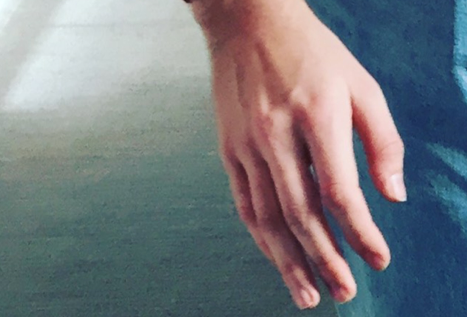HANDS AS OBJECTS
THE PERFORMATIVE OBJECTS OF HANDS FOR DEAFHOOD
From the flexure of the wrist, to the abductor digiti minini (the muscle that draws out the little finger), and in between the proximal and distal traverse palmar creases, there lies a language. And if you look closely you can see it. How can hands be articulated as ‘vibrant matter’ within the developing discourse of Deafhood? Luke Mosley is a BA(Hons) Theatre and Performance graduate with an interest in the representation of Deaf and disabled audiences, the current accessibility provisions within theatre, and how in turn this affects the engagement of those audiences.
 Researching as a child of Deaf adult (Coda), known previously as HCDP (Hearing Child of Deaf Parents), Luke’s interactivity between the Deaf and Hearing communities gives him a distinct outlook when the two communities meet. His research has allowed him to recognise the gravity of the hands, the hands as objects of communication and, due to the personal regard given to the hands by users of sign language, one could perceive the hands as a separate entity to the body. An extremity with its own language, and as a kind ‘vibrant matter’, as articulated by Jane Bennett (2010).
Researching as a child of Deaf adult (Coda), known previously as HCDP (Hearing Child of Deaf Parents), Luke’s interactivity between the Deaf and Hearing communities gives him a distinct outlook when the two communities meet. His research has allowed him to recognise the gravity of the hands, the hands as objects of communication and, due to the personal regard given to the hands by users of sign language, one could perceive the hands as a separate entity to the body. An extremity with its own language, and as a kind ‘vibrant matter’, as articulated by Jane Bennett (2010).
Deafness vs Deafhood
The term d/Deaf is now the most commonly used appellation to differentiate between two groups of people. The lowercase ‘deaf’ asserts the medical model of ‘deafness’, describing those with an audiological impairment, whether full or partial. Those who consider themselves ‘deaf’ only recognise it for the medical meaning and do not usually acquaint themselves with Deaf communities, Deaf culture or use a form of sign language. (Ladd, 2003: xvii) Whereas, the capitalised term ‘Deaf’ describes those who identify as Deaf, whose first/main language is sign, and acculturated to Deaf communities, clubs and Deaf culture. The term ‘Deafhood’ coined by Paddy Ladd in Understanding Deaf Culture: In Search of Deafhood was generated in order to represent and describe the state of being Deaf; what it means to be Deaf. This is in response to the term ‘deafness’, a terminology forged on the medical model focusing on audiological impairment rather than being: this defined the culture by its impairment rather than its history.
Merleau-Ponty begins to undo the invisibility of hands when he states ‘[t]he subject, when put in front of his scissors, needle and familiar tasks, does not need to look for his hands or his fingers, because they are not objects’ and yet also references ‘intentional threads’ which acknowledge hands as objects (Merleau-Ponty. 1981: 106). In response to this agent spectrum, Bennett suggests that humanity and nonhumanity are engaged in ‘an intricate dance’ Bennett, 2010: 31).
For Deafhood, hands symbolise a community, a history and a culture. Paradoxically, the hands represent a distancing from a medical model. The semiotics of the hands for their communicational attributes as well as various representations acknowledge the hands as objects that matter.



